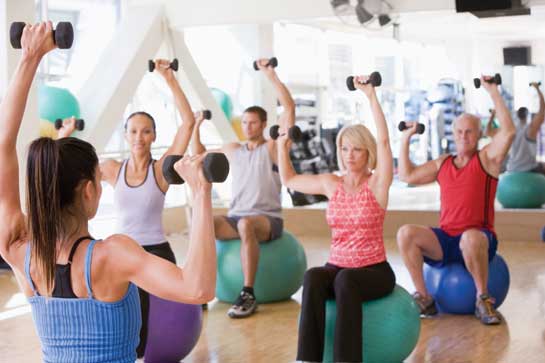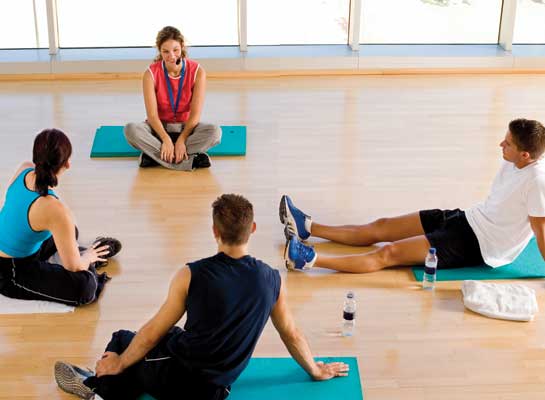
BY CHRIS FREYTAG
New year, new members. How about new group fitness instructors? With the ever-growing population of those looking to get fit, there is always a need for new instructors with fresh enthusiasm to lead group fitness classes. If you are thinking about making the leap, or know someone who should, this is your guide to becoming the best group fitness instructor you can be.
Is Group Fitness Training for You?
Prior to obtaining my first group fitness certification in 1989, I was completely motivated by an instructor who taught a Tuesday/Thursday evening aerobics class. Although some would have thought she held a Ph.D. in enthusiasm, she was actually a legal assistant by day. The reality is that many group fitness instructors are also professionals in other fields. Many, if not most, get their start because fitness is their passion and their creative outlet, rather than their main form of income. For many, teaching group fitness can be a great side-gig. However, whether you are a full- or part-time instructor, group fitness instructors typically take their role as an educator, motivator and instructor very seriously.

Therefore, where do new group fitness instructors come from? In the midst of most classes is a member who shines not only in dedication to attendance and performance of each move, but in attitude, leadership skills and passion for the craft. With a little education and the desire to learn more, this is just the kind of person who can become a star instructor. Other great instructors may have had dance backgrounds and now their passion for fitness has led them to instruct. Some may be working or stay-at-home moms who love health and fitness and want a supplemental income. And of course, like me, many group fitness instructors are also personal trainers who appreciate the motivation of a group atmosphere and decide to teach as a creative outlet…not to mention the instant pool of potential personal training clients you will meet. In addition, many college students are getting a jump start and sitting for their group fitness certification while obtaining degrees in health-related fields. Let’s take a deeper look at the many ways to get involved in the world of group fitness.
Getting Started
Like most people-focused businesses, forming relationships is key. Get to know the instructors and trainers in the club/facility/community center you frequent. Talk to them before and after class and tell them your name. Once you have established relationships, visit the head of the group fitness department or follow the chain of command to determine who is in charge of hiring.
Start by asking exactly what is required to begin teaching at their facility. Many of the larger chain health clubs hold regular auditions. Typically, you will be asked to plan a few minutes of instruction. If this is the case, teach to your strength. Choose the format with which you feel most secure, whether it is step, kickboxing or strength training, and go at it with confidence. Remember, the job of the instructor is to take control of a group of people, understand movement, cue good form and connect the movement to music.
Other facilities, like the YMCA, may do their evaluations differently. According to Sean Levesque, director of Group Exercise and Specialty Programs for the Twin Cities YMCAs, “Instructors are typically hired from within. Many are members who have already created relationships with the staff. If someone applies from the outside the “Y,” they will do a one-on-one audition and then all applicants are required to teach six times with a veteran instructor before teaching their own class.”
In addition, you will want to inquire about certification requirements as these differ from place to place. Some, like the YMCA, will require you to obtain your national group fitness certification before being hired, while others, like Lifetime Fitness or L.A. Fitness, will give you a period of time after being hired to acquire the necessary credentials including certification and CPR.
Mentoring is a Must
Having a mentor is an invaluable asset when entering any new profession, and the field of fitness is no exception. Most of us who teach group fitness were inspired to teach by one of our past or present instructors. Find an instructor you admire and ask for tips, ideas and maybe even a little practice time. Most instructors will not only be flattered by your request, but excited to help you improve. Many clubs offer formal mentoring programs where new instructors are paired up with someone who has been mastering the craft for a bit longer. Be sure to ask if this is available. A seasoned professional has a wealth of knowledge to share, including tips on everything from planning a class to music and cueing.

Preparing for and Obtaining a Certification
Whether a fitness certification precedes or comes after the hiring, it is a crucial part of being a good instructor. Even if it is not required at the facility where you will be working, a Group Fitness Instructor certification is an excellent way to put you ahead of your peers not only in knowledge and skill, but perhaps also in pay.
Not only does ACE offer one of only two group fitness certifications in the country that is NCAA accredited, it can also help you prepare. “ACE has exam preparation assistance that ranges from formal classroom and small-group mentoring, to the online study coach that comes right into your home,” says Jerry Napp, M.A., National Accounts Manager for ACE. “ACE also has partnered with 60 colleges that teach a 16-week GFI course. Most are taught at campus recreation locations and are open to the public as an adult education course.” The ACE Web site includes information on preparation classes, school locations and contact information.

What does taking the exam entail? “The ACE Group Fitness Instructor Certification Exam follows the same format as all other ACE certification exams, with 150 multiple-choice questions. The candidate can take the paper/pencil exam at more than 40 sites on a quarterly throughout the USA,” explains Napp. “However, computer-based testing is a more convenient format for most candidates. With more than 450 sites in the U.S. (15 in Canada), there should be a site that is both nearby and ready when you are.”
Many universities now offer the option to sit for the ACE Personal Training Exam and are moving toward offering the ACE Group Fitness Instructor Exam. For example, Indiana University (IU) offers a program that develops group fitness instructors as a part of the Fitness Specialist degree program. This four-year degree program prepares fitness professionals for all aspects of running a fitness program. Students take all the foundational science courses necessary to understand how the body works (structural kinesiology, anatomy, exercise physiology), as well as leadership classes focusing on group exercise instruction, personal fitness instruction, exercise testing and program design, and fitness management. “This kind of program sets us apart from other universities,” says Carol Kennedy-Armbruster, senior lecturer for IU’s Fitness Specialist Program. “Many exercise science degree programs expect the students to find experience and apply the knowledge on their own. We believe in integrating the knowledge with the skills. Our methods courses combined with the exercise science classes make for a solid fitness professional who can successfully lead group exercise, personal train, and manage a fitness program overall.”
You’re Hired!
Every group fitness instructor remembers experiencing a horrible case of the jitters during their first few classes. It can be overwhelming at first, but try to keep it in perspective and don’t take yourself too seriously. On the other hand, your class may be the best part of someone’s day—what you do matters and matters very deeply to many people. Particularly when you first start teaching, you will need to put in a significant amount of time preparing for your class. The more prepared you are, the more confident you will be when you walk in to teach. The more confident you are, the more it shows to your students and the more comfortable they will be putting their precious workout time in your hands.
So, first and foremost, plan. Plan your music. Plan your class sequence. Practice your moves. Say your class introduction out loud in the mirror. As part of your planning keep in mind the ever-important K.I.S.S. rule: Keep It Simple and Straightforward. Start with a few very basic, easy moves and progress a little at a time. The variety and fun in the class will come from your personality, teaching style, cueing and instruction. The moves, however, should be kept simple rather than complex until you are more comfortable with your style. People always appreciate basic, easy-to-follow moves. Remember group fitness is about leadership and motivation, not about your own performance.
Second, once you get the plan underway and you’ve taught that first class, start getting to know your participants. Look them in the eye when you teach. Venture out and walk among the group once or twice. And learn their names. Before and after your class is the critical time to invest just a few minutes getting to know one or two people each time. Write their names down as soon as they leave so you don’t forget and then use their names during and outside class time. This will create a very personal feel to each class, not only for those you’ve named but also for the others in attendance.
Finally, keep learning. The more you know, the better you will be. Take some kinesiology or human anatomy courses. Learn the scientific terms to go along with your layman’s lingo. For instance, “Squats will help strengthen your quadriceps muscle—that’s the front of your thigh.” By sharing your knowledge, you not only increase your own credibility, but you empower your participants as well.
For more information about becoming an ACE-certified Group Fitness Instructor, visit the ACE website.
_____________________________________________________________________

CHRIS FREYTAG is the author of the new book, Two Week Total Body Turnaround, and is the fitness expert and a contributing editor for Prevention magazine. She is ACE certified and a member of the ACE Board of Directors, a master trainer for SPRI Products and the creator of numerous fitness DVDs including Prevention Fitness Systems.